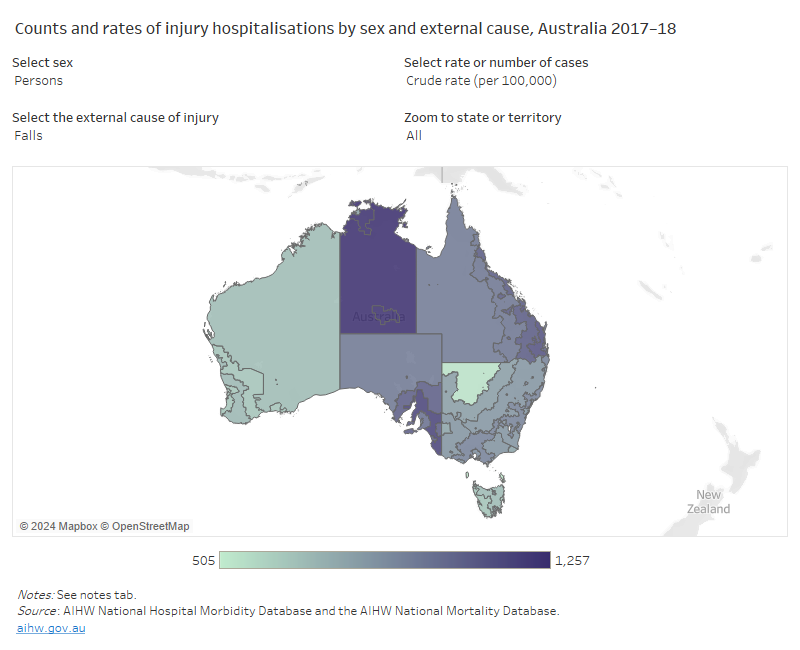Variation by remoteness for different causes
Rates of injury hospitalisation and deaths due to a range of external causes vary according to the remoteness of a person’s usual residence. In many cases rates rise with increasing remoteness.
It is not always possible to identify specific reasons for the patterns of hospitalised injuries and deaths seen within different external causes according to the remoteness of a person’s usual residence, particularly when comparing states and territories. Differences in health care access, utilisation and quality between rural and urban populations can contribute to increases in hospitalisations and deaths for all external causes of injury to varying degrees. Where possible, specific factors that contribute to the varying rates of hospitalisations and deaths by remoteness are mentioned below.
Figures 3 and 4 show the age-standardised rates of hospitalised injury and injury deaths in Australia by a selected number of external causes of injury. For injury hospitalisations, rates rise consistently with increasing remoteness for hospitalisations; largely due to transport crashes, falls and assaults. For the other external causes of injury there is some minor variation, but the same overall trend is present. Rates rise consistently with increasing remoteness for deaths due to transport crashes, thermal injuries, suicide and homicide. For accidental poisoning deaths and deaths due to falls there was less of a clear-cut relationship with remoteness of usual residence.
Differences in rates of injury hospitalisations and deaths by different external causes can be explored in the data visualisation below (Interactive 4). Some additional commentary on each of the external causes is also presented.
Figure 3: Age-standardised rates of selected external causes of hospitalised injury cases, remoteness of usual residence, Australia 2017–18
Notes
- Based on place of usual residence.
- Rates are age-standardised to the 2001 Australian population (per 100,000).
Source: AIHW National Hospital Morbidity Database.
Figure 4: Age-standardised rates of selected external causes of injury deaths, remoteness of usual residence, Australia, 2017–18
Notes
- Based on place of usual residence.
- Rates are age-standardised to the 2001 Australian population (per 100,000).
Source: AIHW National Mortality Database.
Transport crash injuries
Many factors contribute to the increase in hospitalisations and deaths due to transport crashes in Remote and Very remote regions including travel distances, road conditions, higher speed limits and unsealed roads. Rates of hospitalised injury and death increased with increasing remoteness of usual residence for transport crashes. For injury hospitalisations for residents of Very remote areas, the rate was twice as high as for those living in Major cities, and for transport crash deaths the rate was 5 times as high.
Accidental poisoning
The rate of hospitalised injury due to accidental poisoning rose with increasing remoteness up to a point with the highest rate occurring for residents of Remote regions (67 cases per 100,000). In contrast, there was no relationship between rates of accidental poisoning deaths and remoteness of usual residence.
Falls
Rates of hospitalised falls injury increased with increasing remoteness of usual residence. The rate of hospitalised falls injury for residents of Major cities was 793 cases per 100,000 compared with 1,070 for those living in Very remote areas. The rate of fall related deaths was not as closely linked to remoteness of usual residence with a lower rate of fall injury deaths for residents of Very remote areas.
Thermal injury
Environmental risk factors for burn injury can be more prominent in rural and regional areas and include exposure to different occupational (for example, hot farm machinery, back burning) and recreational (for example, campfires) hazards (AIHW 2016). For thermal injury hospitalisations for residents of Very remote areas, the rate was 5 times as high as for those living in Major cities. Rates of thermal injury deaths also increased with increasing remoteness of usual residence.
Intentional self-harm/Suicide
Difficulty of access to mental health services in rural and remote areas is an additional contributing factor to the higher rates of intentional self-harm and suicide deaths in increasingly remote areas. Rates of hospitalised intentional self-harm increased with increasing remoteness up to Remote areas but were slightly lower for residents of Very remote areas. For suicides, rates increased with increasing remoteness to be twice as high for residents of Very remote areas compared with those living in Major cities.
Assault/Homicide
For hospitalised assault cases, rates of assault for residents of Major cities were 65 cases per 100,000 population compared with 1,244 cases per 100,000 population those living in Very remote areas. Rates of homicide were 8 times higher for residents of Very remote areas (5 cases per 100,000 population) compared with Major cities (0.6 cases per 100,000 population). This is influenced by the higher hospitalisation rates for injury-related assaults for Indigenous Australians living in remote areas.
Interactive 3
This data visualisation consists of a map, chart and table on separate tabs describing counts and rates for each of injury hospitalisations and deaths by sex, by external cause, and by state and territory of remoteness of usual residence. A notes tab is also available. The reader can select to display by sex, number or rate, external cause or state. The default view is a map of Australia showing rates of injury hospitalisation for unintentional falls per 100,000 population. The map shows the highest rate of falls injury hospitalisation is for residents of Very remotes regions of the Northern Territory (1,257) and the lowest rate is for residents of Very remote regions of Tasmania (505).



